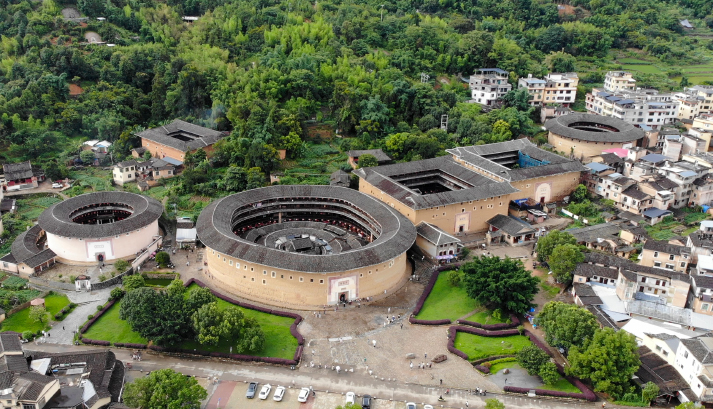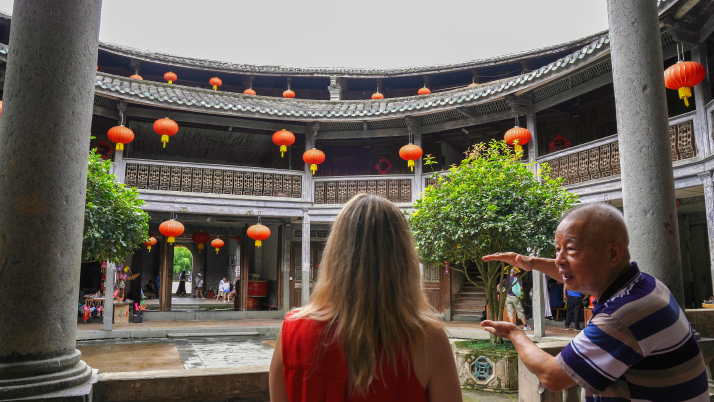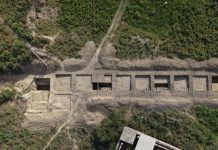These are lines in a promotional video presenting the Chengqi Building, a tulou or earthen house built in the Qing Dynasty (1644-1911) in Yongding County, Longyan, Fujian Province. As the tallest and oldest existing circular building in the province, locals refer to it as the “King of Tulous.”
In its heyday, the building housed more than 600 people and protected them from invasion. Nestled in the mountains, its residents use the limited farmland available to them to grow rice, persimmons and tea.
But in recent years, tourists curious about the tulou have come flocking to the labyrinthine architecture.
Today, with the exception of the fourth concentric circle—the ancestral hall—many of the first-floor rooms in the other three circles have been converted into small shops selling souvenirs and local products such as tea.
The hospitable tulou residents often invite visitors to sit down and take a break before climbing the steep stairs for a beautiful view of the entire building.
As tourism has flourished, the local way of life has changed, and so has the fate of the tulou. They are now better protected and better used.

Unchanged by change
Today, Fujian is home to about 30,000 tulous. They are the traditional communal residences of the Hakka people, combining functions of accommodation and defense fortress.
Migrants to the southeastern area from the country’s central plains, this ethnic subgroup of the Han Chinese built these unique dwellings with high fortified mud walls topped by tiled roofs with wide overhanging eaves.
The buildings are divided vertically and each family has two or three rooms on each floor. A tulou houses an entire village or clan, with families living in close proximity to each other and discussing village or clan affairs together, exemplifying a particular form of communal living and culture.
In addition to the integrity of the buildings themselves, the surrounding agricultural and forest landscape also remains intact, as the buildings have been designed according to the principles of fengshui, the ancient Chinese art of arranging buildings and space to achieve harmony for peace and prosperity.
In 2008, 46 Fujian tulous, including the Chengqi and Zhencheng buildings, were granted world heritage status by UNESCO. Since that landmark moment, Lin Rigeng, a 73-year-old resident of the Zhencheng Building in Yongding, has witnessed many pleasant changes in his hometown.
“The local economy, environment and transportation have all improved,” he told Beijing Review.
The building was constructed in 1912 by Lin’s grandfather, a wealthy businessman, and took nearly five years and a large sum of money to complete. Lin, who was born in the four-story circular building, began working as a tour guide in the 1990s, educating visitors about the history and culture of both the architecture and the Hakka people.
“It is characterized by two rings of houses, with the outer ring being made of rammed earth and the inner ring being decorated with Western ornaments. It housed more than 200 people in its heyday. Now, more than 86 residents from 15 households live here,” he introduced.
Though younger people may favor an apartment in a modern community, Lin still prefers living in a tulou as it is quiet and cool in summer and stays warm in winter.
He added that since the building has become a scenic spot that attracts a growing number of visitors, residents have been able to increase their income by selling souvenirs, and the once-poor village is now better off.
Lin Shangkang, son of Lin Rigeng, moved back into the tulou in 2004. The former middle school teacher has picked up the baton from his father to promote Zhencheng Building’s culture and operates a homestay there.
“When tourists from different parts of the world come here and talk with us, we try to show them Hakka culture in a genuine way,” he told Beijing Review.
Magdalena Rojas from Chile said after visiting the building that she liked how people there still hold on to a traditional way of life, especially in modern times and with the many rapid changes that have taken place in China over the past four decades.
“The people who still live in the tulou bring us back to the ancient traditions of China and a more communal style of living,” she continued.

A new chapter
A six-minute drive southwest from the Zhencheng Building is the Huanxing Building.
The 500-year-old construction, which has suffered two fires, is not on the UNESCO list. But it has found a “younger” way to reinvent itself.
A renovation project got underway in July 2022, when the building was in bad shape. Locals had even been using it as a warehouse.
Fortunately, the Yongding Government initiated the project with the participation of local businesses.
According to Luo Honghua, director of the Huanxing Tulou cultural tourism project, the renovation project cost 120 million yuan ($17 million).
With the support of Chinese tech giant Tencent, the building has been used as the backdrop for the online game Moonlight Blade. The game is also the theme of the hotel, developed from the circular house and operated by a local company.
What’s more, the hotel strikes a balance between authentic tulou flavor and comfortable living conditions. It has maintained its original design while adding modern amenities such as elevators.
“I like the fact that all the traditional architectural elements have been preserved in the renovation process,” Rojas said, adding that it has all the amenities of a first-class hotel.
The converted ancient fortress caters to the diverse needs of younger travelers, said Jin Laiwen, Vice General Manager of Fujian Hakka Xiangxu Hotel Management Co. Ltd., which is involved in the project.
“As the local economy grew, residents began to build new homes. Many tulous were abandoned and became vulnerable to decay and even collapse. We save them by renovating them so that more people can live in them and bring them back to life,” Jin continued.
As night falls, visitors to the building will enter a world of Chinese martial arts novels or movies as footage from the game is adapted into an interactive role-playing event.
In between the song and dance performances, costumed actors invite the audience to play games. Traditional clothing is provided to further immerse visitors in the experience.
“The future of the tulou lies in their positive social and cultural impact. It is important for more younger people to experience these buildings and the aesthetics and history behind them,” Luo told Global Times newspaper. –The Daily Mail-Beijing Review news exchange item





